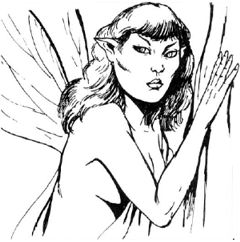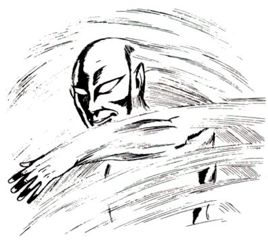

MC Volume One & Two • Monstrous Manual

| Sylph | Aerial Servant | |
|---|---|---|
| Sylphe | Serviteur aérien | |
| Climate/Terrain: | High altitudes or treetops | Any (see below) |
| Frequency: | Very rare | Very rare |
| Organization: | Solitary | Solitary |
| Activity Cycle: | Any | Any |
| Diet: | Omnivore | Wind |
| Intelligence: | Exceptional (15-16) | Semi- (2-4) |
| Treasure: | Q×10 X | Nil |
| Alignment: | Neutral (good) | Neutral |
| No. Appearing: | 1 | 1 |
| Armor Class: | 9 | 3 |
| Movement: | 12, Fl 36 (A) | Fl 24 (A) |
| Hit Dice: | 3 | 16 |
| THAC0: | 17 | 5 |
| No. of Attacks: | 0 | 1 |
| Damage/Attack: | Nil | 8-32 (8d4) |
| Special Attacks: | See below | See below |
| Special Defenses: | See below | +1 or better weapon to hit |
| Magic Resistance: | 50% | Nil |
| Size: | M (4-5’ tall) | L (8’ tall) |
| Morale: | Elite (14) | Elite (14) |
| XP Value: | 2,000 | 9,000 |

Sylphs are beautiful, humanoid women with wings like dragonflies. Their wings are 4-5 feet long and translucent, clear, or spotted with iridescent color. Their long, bright, hair may be any “normal” color, or blue, purple, or green. They wear flowing, diaphanous robes which accent their wings or hair. Sylphs are related to air elementals and to nymphs, perhaps originating as a cross-breed between nymphs and aerial servants.
Sylphs are friendly and may (20%) befriend adventurers and give them aid in exchange for a favor.
Sylphs speak Common and their own musical language.
Combat: Sylphs do not physically atack their opponents. Instead they employ a variety of magical abilities.
A sylph can cast spells as a 7th-level wizard, and most prefer spells of elemental air. In addition, the sylph can become invisible at will and summon an air elemental once each week.
Habitat/Society: Sylphs rarely touch ground in the lowlands. They are fond of travel, and it is rare to find one near its home.
Sylph nests are highly individualistic, some formed from whatever materials are available, others are elaborate retreats perched in tall trees or carved into mountains. Sylphs prefer simple and light possessions, keeping only gems and magical items as treasure. They often trade wealth for furnishings, such as light draperies, silks, and pillows.
There is a 1% chance that a sylph’s home holds an egg or a child. All sylphs are female and mate with humanoid males, preferring elves, but sometimes accepting a human or halfling mate. Three months after conception, the sylph lays a pearly egg in a special nest, and summons an air elemental to guard it. Six months later, the egg hatches a baby girl with wing buds. The child grows at the same rate as a human child, gaining magical abilities at age five, and full flight by age 10.
The sylph has the innate ability to levitate; wings are needed only to provide thrust. If a sylph’s wings are injured, it can only glide or hover. Anti-magical attacks may ground a sylph by negating its power of levitation. Sylphs live for up to 1,000 years, retaining their youthful looks throughout their lives.
Every 28 years, all sylphs gather in a grand meeting to trade, share news, renew friendships, and welcome young sylphs.
Ecology: Sylphs usually maintain their distance from the more mundane humanoid races, but associate freely with nymphs and dryads. Aerial monsters occasionally feed on them, but they are in greater danger from evil humanoid males who attempt to capture them for dark purposes.

The aerial servant is a semi-intelligent form of an air elemental native to the elemental plane of air, the ethereal plane, and the astral plane. An encounter with an aerial servant in the prime material plane is usually the result of a conjuration by a cleric.
When encountered in the material plane, aerial servants normally are invisible. They are dimly visible in their native planes, resembling legless humanoids made of sparkling blue smoke. They have empty eye sockets, a thin slash for a mouth, and two long arms with large hands and four thick fingers.
Combat: An aerial servant generally avoids combat in its native planes. However, if attacked or threatened, it responds by attempting to grab and strangle its opponent. The aerial servant’s first successful roll to hit means it has grabbed its victim; in each successive round that it holds its victim. the aerial servant, if it desires, automatically inflicts 8-32 hp of damage. An aerial servant is very strong and can easily carry weights in excess of 10,000 gold pieces. A character must have a Strength of 18 to have any chance of breaking free. For each percentage point score the character has, there is a like chance to break free of the aerial servant’s grasp; for instance, a character with an 18/50% Strength has a 50% chance of breaking free, while a character with a 00% or 19 automatically breaks free. (If the grasped creature has no Strength rating, roll the appropriate number of the creature’s Hit Dice and 16 HD for the aerial servant; if the creature’s total is higher, it breaks free.)
An aerial servant in the command of a cleric will not fight for him, but will complete any other assigned duty, usually finding and returning an object or victim. If assigned to return a victims the aerial servant grabs the victim as described above. Additionally, those attacked by an aerial servant in the material plane have a -5 surprise modifier. If the summoning cleric does not protect himself by casting protection from evil or by standing inside a protective symbol, the aerial servant will attempt to crush and kill him. If the aerial servant is prevented from completing its assigned mission, it becomes insane, returns to the cleric, and attempts to kill him.
Habitat/Society: Aerial servants are not oganized into families, communities, or any other social units. They do not collect treasure. Aerial servants pass the time by soaring on the elemental, astral, and ethereal wind, exploring the infinite mysteries of their native planes. As they have no permanent lairs, aerial servants have a virtually limitless range and are not tied to any specific territory. They are particularly drawn to areas of extreme weather, such as the ether cyclones of the ethereal plane (sinuous, serpentine columns of force), the psychic wind storms of the astral plane (hurricane-like areas of darkness), and the aerial maelstroms of the plane of elemental air (doughnut-shaped tornadoes). Generally, aerial servants are able to avoid the dangers of these phenomena. However, if a careless aerial servant is caught up in one of these storms, there is a 50% chance it will be blown in two, with each half becoming a separate aerial servant. This is the only way aerial servants reproduce, an extremely painful process the aerial servants strive to avoid.
Aerial servants will not voluntarily leave their home plane and have no interest in material plane affairs. They resent being summoned by clerics to the prime material plane and will attempt to complete their minions as soon as possible in order to return home.
Ecology: Aerial servants do not consume food for nourishment. Instead, they are refreshed and energized by being buffeted in the planar winds. Long periods of calm weather cause aerial servants to grow listless and weak. If an aerial servant is not exposed to a planar wind in excess of 30 miles per hour for 30 consecutive days, it risks suffering damage; beginning on day 31, it has a 10% chance per day of losing 1d8 hp. Aerial servants recover lost hit points at the rate of 1d8 per hour of being buffeted by planar winds in excess of 30 miles per hour. They are unaffected by winds of the prime material plane.
Aerial servants are wanderers drawn to areas of extreme weather. If caught in a storm, there is a 5% chance it will be blown in two; this is the only way it can reproduce.
Aerial servants have no natural enemies. They rarely associate with other creatures, although they do have an affinity for air elementals, occasionally tagging along after them. However, air elementals avoid and discourage contact with aerial servants, considering them an inferior species.
